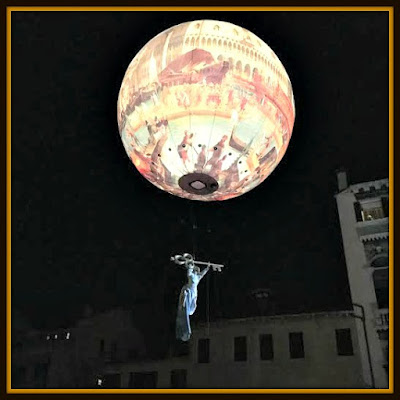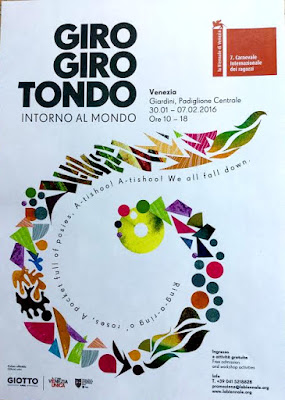 |
| Venice Carnival 2016 Opens - Photo: Cat Bauer |
The date depends on Easter, which is a moveable feast, celebrated on the first Sunday after the first full moon that occurs on or after the March Equinox. This year, that full moon is on March 23, so it means Easter will be on Sunday, March 27. Ash Wednesday occurs exactly 46 days before Easter -- 40 fasting days not counting Sundays -- which will be February 10th this year. Which means that Mardi Gras, the last night to get crazy before the fasting begins, is on February 9th. Got all that?
Journalists were flying all around Venice yesterday on their magic carpets, since there were four press conferences scheduled at the same time:
1. VENICE BIENNALE 7TH INTERNATIONAL KID'S CARNIVAL
 |
| Venice Biennale 7th International Kid's Carnival |
2. MURANO GLASS MUSEUM
 |
| A Light for Emilia-Romagna - Photo: Consorzio Promovetro Murano |
The Consorzio Promovetro of Murano decided to use their expertise to help their friends in the neighboring region, and transferred the chandeliers from Ferrara to Murano (with a lot of help from all sorts of Italian powers), where they have been lovingly restored over the last three years. Luciano Gambaro, President of the Murano Glass Promotion Consortium Promoverto said, "It is a great joy for us to use our professionalism to help the population of Emilia-Romagna that has suffered so much. These chandeliers have become a symbol to them because they survived the earthquake despite their fragility." Teatro La Fenice curated the design, and Venetian author Alberto Toso Fei curated the book that accompanies the exhibition.
3. CASA DEI TRE OCI
 |
| Alice's Looking Glass - Maurizio Trifilidis |
Next, on the first floor, are 75 images of Venice by Roberto Polillo, and on the second floor is Giulio Obici's Il Flâneur Detective. A flâneur is someone who walks the streets, observing the life around him. Giulio Obici (1934-2011) was a columnist and special correspondent who investigated terrorism in Italy, whose short novels were published posthumously in 2015. The photos on display are sort of like an author's notes which were photographed instead of written.
4. PEGGY GUGGENHEIM COLLECTION
 |
| Portrait of Zoe Sharkey by Jack Tworkov (1948) |
I fell in love with Claire Falkenstein (1908-1997), an American artist who created esoteric structures that seemed to be born in outer space. Anyone who has entered the Peggy Guggenheim Collection from the side gate already knows her work, The New Gates of Paradise, made from welded iron rods and colorful chunks of Venetian glass.
 |
| The New Gates of Paradise by Claire Falkenstein (1980-97) Photo: Cat Bauer |
Ciao from Venezia,
Cat
Venetian Cat - The Venice Blog





